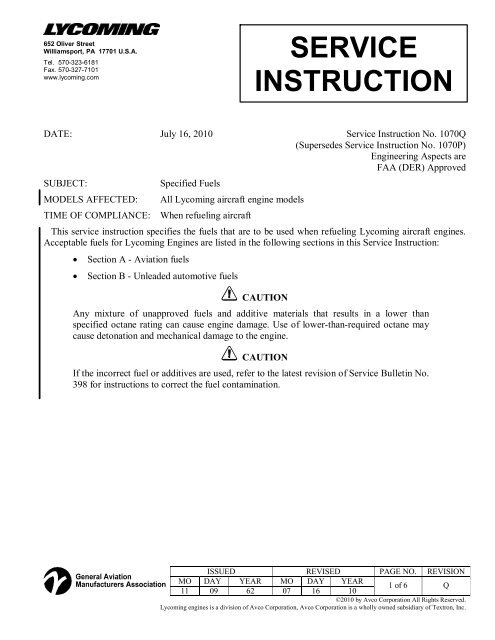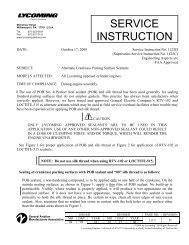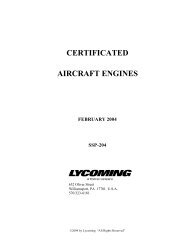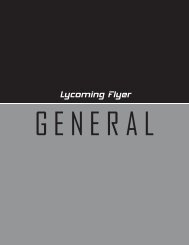SERVICE INSTRUCTION - Textron Lycoming
SERVICE INSTRUCTION - Textron Lycoming
SERVICE INSTRUCTION - Textron Lycoming
Create successful ePaper yourself
Turn your PDF publications into a flip-book with our unique Google optimized e-Paper software.
652 Oliver Street<br />
Williamsport, PA 17701 U.S.A.<br />
Tel. 5703236181<br />
Fax. 5703277101<br />
www.lycoming.com<br />
DATE: July 16, 2010 Service Instruction No. 1070Q<br />
(Supersedes Service Instruction No. 1070P)<br />
Engineering Aspects are<br />
FAA (DER) Approved<br />
SUBJECT: Specified Fuels<br />
MODELS AFFECTED: All <strong>Lycoming</strong> aircraft engine models<br />
TIME OF COMPLIANCE: When refueling aircraft<br />
This service instruction specifies the fuels that are to be used when refueling <strong>Lycoming</strong> aircraft engines.<br />
Acceptable fuels for <strong>Lycoming</strong> Engines are listed in the following sections in this Service Instruction:<br />
• Section A Aviation fuels<br />
• Section B Unleaded automotive fuels<br />
CAUTION<br />
Any mixture of unapproved fuels and additive materials that results in a lower than<br />
specified octane rating can cause engine damage. Use of lowerthanrequired octane may<br />
cause detonation and mechanical damage to the engine.<br />
CAUTION<br />
<strong>SERVICE</strong><br />
<strong>INSTRUCTION</strong><br />
If the incorrect fuel or additives are used, refer to the latest revision of Service Bulletin No.<br />
398 for instructions to correct the fuel contamination.<br />
ISSUED REVISED PAGE NO. REVISION<br />
MO<br />
11<br />
DAY<br />
09<br />
YEAR<br />
62<br />
MO<br />
07<br />
DAY<br />
16<br />
YEAR<br />
10<br />
1 of 6 Q<br />
©2010 by Avco Corporation All Rights Reserved.<br />
<strong>Lycoming</strong> engines is a division of Avco Corporation, Avco Corporation is a wholly owned subsidiary of <strong>Textron</strong>, Inc.
Section A Aviation Fuels<br />
Domestic and foreign leaded aviation fuel grades listed in Table A1 are still applicable for use in all<br />
<strong>Lycoming</strong> engines. Leaded aviation fuel grades 91/96 and 115/145 have been discontinued and have been<br />
replaced by the low lead grade fuel: 100LL. Leaded aviation fuel grade 80/87 has limited availability in the<br />
U.S. as well as overseas. Commercial fuel grades 100 and 100/130 having Tetraethyl Lead (TEL) content of<br />
up to 4ml/U.S. gallons are approved for use in all engines certified for use with grade 100/130 fuel.<br />
ASTMD910<br />
Fuel Grades<br />
Grade Color<br />
TABLE A1<br />
AVIATION GASOLINE FUELS<br />
ASTMD910 (Revision A)<br />
Fuel Grades<br />
Max. TEL<br />
M1/U.S.<br />
gal. Grade Color<br />
Max. TEL<br />
M1/U.S.<br />
80/87 Red 0.5 80 Red 0.5<br />
ISSUED REVISED PAGE NO. REVISION<br />
MO<br />
11<br />
DAY<br />
09<br />
YEAR<br />
62<br />
MO<br />
07<br />
DAY<br />
16<br />
YEAR<br />
10<br />
2 of 6 Q S.I. 1070<br />
Alternate Specification<br />
Fuel Grades<br />
Max. TEL<br />
M1/U.S.<br />
gal.<br />
AVGAS<br />
91/96UL* None 0<br />
gal. Grade Color<br />
91/96 Blue 2.0 100LL Blue 2.0 B91/115** Green j<br />
100/130 Green 3.0 100 Green 3.0 91** Yellow j<br />
115/145 Purple 4.6 B95/130** Amber j<br />
* Trade name for colorless unleaded fuel produced by Hjelmco Oil, Inc. of Sollentuna, Sweden and stated<br />
by the company to conform to ASTM D910 specifications except for the lead content and colorant.<br />
Specification of Hjelmco AVCAS 91/96UL (or any other brand/trade name) does not constitute a<br />
commercial endorsement by <strong>Lycoming</strong>.<br />
** B91/115 and B95/130 are available for use in the Commonwealth of Independent States (CIS). Fuel<br />
currently designated 91 is available for use in the Ukraine. These fuels are specified by GOST101272.<br />
Max. TEL content is 2.5g/kg (B91/115) and 3.1g/kg (B95/130). Ukrainian 91 is specified by<br />
TU38.590148196. Max. TEL content is 2.5g/kg.<br />
In some overseas countries, grade 100LL fuel is colored green and designated as “100L”.<br />
If fuels specified in Table A1 are not available, a higher grade leaded aviation fuel listed in Table A2, as<br />
an alternative, may be used and are subject to the restrictions described in the footnotes. Although Table A<br />
1 lists specified and alternate fuels that can be used safely, this list in no instance permits use of fuels of a<br />
lower grade. Any fuel used in <strong>Lycoming</strong> engines must conform to Specifications ASTMD910 and MILG<br />
5572F.<br />
NOTE<br />
Isopropyl alcohol in amounts not to exceed 1% by volume may be added to the aviation<br />
fuel (not automotive fuel) to prevent ice formation in fuel lines and tanks. Although<br />
approved for use in <strong>Lycoming</strong> engines, do not use isopropyl alcohol in the aircraft fuel<br />
systems unless recommended by the aircraft manufacturer.
TABLE A2<br />
ENGINE MODELS APPROVED FOR AVIATION FUELS<br />
SPECIFIED FUELS<br />
ASTM D910<br />
Engine Models Certificated For Use Commercial Grade<br />
O235C, E, H; O290D; O435A,C<br />
With Grade<br />
Designation<br />
80 80<br />
O290D2; O320A, C, E; IO320A,<br />
E; AEIO320E; O340B; O360B, D;<br />
GO435C2*; VO435A; GO480B, D,<br />
F; O540B; VO540A, B 80/87 80<br />
O320B, D; IO320B, D; LIO320<br />
B1A; AEIO320D; AIO320A, B, C;<br />
O360A, C, F, G, J; IO360B, E, L,<br />
M; LO360A; AEIO360B, H; VO<br />
360A, B; IVO360A; HO360A, B,<br />
C; HIO360B; O435A2; GO435C2*;<br />
O480A; O540A, D, E, F, G, H;<br />
IO540C, D, E, N, T; AEIO540D<br />
O235F, G, J, K, L; IO320C, F;<br />
LIO320C1A; IO360A, C, D, F;<br />
LIO360C; AEIO360A; AIO360A,<br />
B; HIO360A, C, D, E; LIO360A;<br />
VO435A, B; GO480C, G; IGO480<br />
A; IO540A, B, E, G, J, K, L, M,<br />
P, R, S, U, V, W, AB, AC, AE;<br />
HIO540A; VO540C; IVO540A;<br />
IGO540A, B; IO580B; IO720A,<br />
B, C, D; AEIO580B<br />
TO360A, C; TIO360A; TVO435A,<br />
B, C, D, E, F, G; GSO480A, B;<br />
IGSO480A; TIO540A, C, D, E, F,<br />
G, H, J, N, R, S, U, V, W, AA,<br />
AB, AE, AF, AG, AH, AJ, AK;<br />
LTIO540F, J, N, R, U, V; TIVO<br />
540A; IGSO540A, B; TIO541A, E;<br />
TIGO541B, C, D, E, G<br />
91/96<br />
100/130<br />
100/130<br />
100LL<br />
Alternate Military<br />
and<br />
Commercial Grades<br />
AVGAS 91/96 UL<br />
4B91/115<br />
or<br />
491<br />
or<br />
15100LL<br />
or<br />
523100<br />
or<br />
5423100/130<br />
AVGAS 91/96 UL<br />
4B91/115<br />
or<br />
491<br />
or<br />
15100LL<br />
or<br />
523100<br />
or<br />
5423100/130<br />
ISSUED REVISED PAGE NO. REVISION<br />
MO<br />
11<br />
DAY<br />
09<br />
YEAR<br />
62<br />
MO<br />
07<br />
DAY<br />
16<br />
YEAR<br />
10<br />
3 of 6 Q S.I. 1070<br />
or<br />
100<br />
100LL<br />
or<br />
100<br />
100LL<br />
or<br />
100<br />
AVGAS 91/96UL<br />
or<br />
4B91/115<br />
or<br />
491<br />
or<br />
4100/130<br />
or<br />
4115/145<br />
4100/130<br />
or<br />
4B95/130<br />
or<br />
4115/145<br />
4100/130<br />
or<br />
4115/145<br />
O320H; O360E; LO360E; O540J,<br />
L; HIO360F1AD 100LL or 100 100LL or 100 4100/130 or 4115/145<br />
* GO435C2 engines with MarvelSchebler carburetor No. 103991 are certificated to use 91/96 fuel.
1 Grade 100LL or 100L in which the lead content is limited to 2 ml. of TEL per gallon are approved for<br />
continuous use in all <strong>Lycoming</strong> engines listed herein. Inspection procedures described in the following<br />
footnotes are not required for engines using this fuel.<br />
2 O235C, O290D, D2 and O435A2, K1 (O4354) engines were built with solid stem exhaust<br />
valves. The use of fuels with higher lead content of more than 2 ml. of TEL per U.S. gallon must be<br />
limited to 25% of the operating time. If specified fuel is not available and usage with high leaded fuel<br />
exceeds 25% of the operating time, inspect the valve stems at every 150 hours of engine operation for<br />
erosion or “necking”. This inspection is accomplished by removing the exhaust manifold and visually<br />
inspecting the valves through exhaust ports. To determine if an engine has solid stem exhaust valves,<br />
remove the rocker cover and look for valve rotor caps which are used with sodium cooled valves but not<br />
with solid stem valves in these particular engines. O235C and O290D models can be converted to<br />
use sodium cooled exhaust valves. See latest revision of Service Instruction No. 1246 for procedure.<br />
3 Early production O320A, C, D; GO435; VO435A and GO480B, D, F were built with solid<br />
stem exhaust valves and their use with fuels having lead content of more than 2 ml. of TEL per U.S.<br />
gallon is limited to 25% of the operating time. If specified fuel is not available and usage with high<br />
leaded fuel exceeds 25% of the operating time, inspect the valve stems at 150 hours of engine operation<br />
for erosion or “necking”. This inspection is accomplished by removing the exhaust manifold and<br />
visually inspecting the valves through exhaust ports. To determine if an engine has solid stem exhaust<br />
valves, remove the rocker cover and look for valve rotor caps which are used with sodium cooled valves<br />
but not with solid stem valves in these particular engines.<br />
4 Continuous use of high lead fuels can result in increased lead deposits both in combustion chambers and<br />
spark plugs causing engine roughness and scored cylinder walls. It is recommended that the use of this<br />
fuel be limited wherever possible; however, when high lead fuel is used, conduct periodic inspections of<br />
combustion chambers, valves and valve ports more frequently and rotate or clean spark plugs whenever<br />
lead fouling is experienced. See latest revision of Service Letter No. L192.<br />
5 See latest revision of Service Letter No. L185 for operating recommendations.<br />
ISSUED REVISED PAGE NO. REVISION<br />
MO<br />
11<br />
DAY<br />
09<br />
YEAR<br />
62<br />
MO<br />
07<br />
DAY<br />
16<br />
YEAR<br />
10<br />
4 of 6 Q S.I. 1070
Section B Unleaded Automotive Fuels<br />
This Section B supplies critical details on the use of automotive fuel in aircraft engines.<br />
Premium or Super Premium grade unleaded automotive gasoline fuels meeting the requirements identified<br />
in Table B1 of this Service Instruction are approved for use only on the engine models listed in Table B2.<br />
Usage of automotive gasoline that does not conform to the parameters described in Tables B1 and B2 is<br />
not permitted.<br />
Background<br />
CAUTION<br />
Automotive ground transportation fuels available direct to consumers (e.g. “pump gas”) are<br />
typically not labeled sufficiently to determine compliance with the requirements stipulated<br />
in Table B1. While indicated octane is generally required for display at retail points of sale,<br />
octane rating methods, fuel vapor pressure, oxygenate content and ethanol content can vary<br />
widely and are generally known only at the wholesale terminal. To ensure compliance with<br />
Service Instruction No. 1070Q, all parameters listed in Table B1 must be satisfied.<br />
Automotive ground transportation fuels have previously been prohibited for use in all <strong>Lycoming</strong> engines.<br />
The primary reason for this prohibition is the fact that ground transportation fuels (gasoline and diesel) are<br />
generally formulated to optimize engine emissions and easeofstarting. These formulations are heavily<br />
influenced by environmental regulations and vary by geographic region and season.<br />
Automotive fuel specifications have evolved in recent years such that ASTM/EN standard fuel ordering<br />
parameters may be utilized to stipulate the necessary properties to enable usage as an aviation fuel for<br />
aircraft engines with low octane requirements. The control parameters that must be specified and examined<br />
for compliance in aviation use are the same as the parameters that must be specified in automotive ground<br />
transport use.<br />
Description<br />
NOTE<br />
Although the automotive fuel listed in Table B1 is approved for use in the <strong>Lycoming</strong><br />
engine models listed in Table B2, further approval is required via a Supplemental Type<br />
Certificate (STC) or Type Certificate (TC) to permit the use of this fuel in the airframe.<br />
The clear, colorless unleaded automotive fuels listed in Table B1 must conform to ASTM D481409b or<br />
EN 228:2008:E. In these specifications, the automotive fuel is classified by an AntiKnock Index (AKI) or<br />
in the case of EN228 Super Premium, a grade designation. The AKI is an octane rating and is the arithmetic<br />
average of the Research Octane Number (RON) and Motor Octane Number (MON).<br />
(RON + MON)/2 = AKI<br />
The AKI or EN228 grade value must be as specified in Table B2 or higher. The AKI or grade value is<br />
critical to engine performance. Table B 2 lists the selected <strong>Lycoming</strong> engine models and the minimum AKI<br />
or grade requirement.<br />
As per ASTM D481409b, the vapor pressure of the fuel must be rated as Class A4 for vapor lock<br />
protection. The letter “A” in this rating refers to the volatility of the fuel and the number specifies the vapor<br />
lock protection class. The ASTM D481409b maximum vapor pressure limit is 9.0 psi (0.62 kPa) maximum<br />
for a Class A rating. Vapor lock can occur at high operating temperatures resulting in diminished fuel flow<br />
to the engine causing loss of engine power, rough engine operation, or engine stoppage.<br />
ISSUED REVISED PAGE NO. REVISION<br />
MO<br />
11<br />
DAY<br />
09<br />
YEAR<br />
62<br />
MO<br />
07<br />
DAY<br />
16<br />
YEAR<br />
10<br />
5 of 6 Q S.I. 1070
CAUTION<br />
Automotive fuels typically have Reid Vapor Pressure (RVP) values between 7 and 9.3 psi<br />
(0.48 and 0.64 kPa) in summer seasons. Automotive fuel specifications allow as high as 15<br />
psi (1.03 kPa) in the winter. In some geographic regions, there is no upper limit to RVP in<br />
the winter season. As vapor pressure increases, the tendency for vapor lock will increase as<br />
well as fuel “boil off” at altitude.<br />
CAUTION<br />
Ethanol is not allowed. Ethanolbased fuels may not be compatible with some fuel system<br />
components. In cases of materials incompatibility, deterioration of metallic and non<br />
metallic components can occur.<br />
Another key aspect of using automotive fuel as aviation fuel is that the fuel must be free of undissolved<br />
water, sediment, and suspended matter.<br />
TABLE B1<br />
UNLEADED AUTOMOTIVE FUEL SPECIFICATION REQUIREMENTS<br />
ASTM D481409b*<br />
Unleaded Automotive Fuel<br />
EN 228:2008:E**<br />
Unleaded Automotive Fuel<br />
Grade Color Grade Color<br />
See Table B2 Clear See Table B2 Clear<br />
*ASTM D481409b, Approved September 2009, must conform to the following requirements:<br />
Octane: See Table B2<br />
Vapor Pressure Class A4<br />
Oxygenates: Less than 1% (NO ETHANOL)<br />
**EN 228:2008:E, Approved July 2008, must conform to the following requirements:<br />
Octane: See Table B2<br />
Vapor Pressure Class A<br />
Oxygenates: Less than 1% (NO ETHANOL)<br />
TABLE B2<br />
ENGINE MODELS APPROVED FOR UNLEADED (TABLE 1) AUTOMOTIVE FUEL<br />
<strong>Lycoming</strong> Engine Models ASTM D4814<br />
Minimum AKI<br />
Required<br />
(RON+MON)/2<br />
ISSUED REVISED PAGE NO. REVISION<br />
MO<br />
11<br />
DAY<br />
09<br />
YEAR<br />
62<br />
MO<br />
07<br />
DAY<br />
16<br />
YEAR<br />
10<br />
6 of 6 Q S.I. 1070<br />
EN228<br />
Minimum Grade<br />
Required<br />
O360 series A, C, F, G & J engines 93 NB.3<br />
HO360C1A 93 NB.3<br />
IO360B1B, B1E, B1F, B1G6, B2E,<br />
L2A, M1A, M1B<br />
93 NB.3<br />
LIO360M1A 93 NB.3<br />
LO360A1H6 93 NB.3







